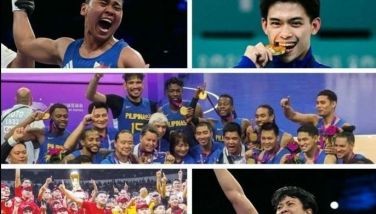The treadmill effect
It’s my last column for 2009 and I end the year by renewing our call for our sports authorities to seriously consider updating the existing Master Plan for Sports if we are to keep up with the rest of the world.
Some sports officials have said that if we want to do much better in international competitions, we should put more emphasis on nutrition (in measurable sports such as track and field) and getting our technical officials, especially in subjective sports such as boxing, taekwondo, karate and wushu) accredited by their respective international federations to protect ourselves from biased officiating in these subjective sports.
These comments make sense especially if nutrition and training of our technical officials were permanently imbedded in a sports master plan (as they were in the Master Plan for 1996-2000 which we prepared when we were at the Philippine Sports Commission or PSC from 1995 to 1998) as a fundamental component of the integrated approach to sports development.
More than nine years ago, on Aug. 22, 2000, I was invited by Sen. Robert Jaworski, chairman of the Senate committee on games, amusement and sports as a resource person on the topic, “...to look into the government’s policy on grassroots sports program (and) determining whether government funds given to private entities as subsidy are spent on the aforesaid purpose with the end in view of developing a national grassroots sports program.”
The first point I made then was that the framework for physical fitness and sports development has essentially been identified over the past several years. I then traced the consultative, deliberative and multi-sector nature of the discussions that took place over 18 months before the draft of the Master Plan was completed with the help of the Australian Sports Commission, the Australian Institute of Sport and Price-Waterhouse (Australia).
With its own mission statement as its guiding light, the PSC formulated two objectives: increased participation in sports by Filipinos (for grassroots sports) and excellence in sports performance by especially talented Filipinos (for elite sports). From these two objectives sprang forth eight strategies, among them: develop opportunities for sports participation and enjoyment and strengthen the PSC’s capability to deliver services.
I pointed out that with a population of 17 million, roughly about 20 percent of the Philippine population, Australia has, in a period of less than two decades, become an Olympic power with plain Australians playing a sport or two at the community level. The Australian grassroots and elite sports development program is now a model copied by several developing countries and even rich countries in the Middle East. Hence, I stated, the Master Plan is a tired and tested model worth pursuing so that the framework would then come to life and become a working and not just a theoretical framework for sports development.
The eight-volume plan emphasizes that the biggest resource of the country remains to be the more than (now)90 million Filipinos and agencies such as the Departments of Education (DepEd), Interior and Local Government (DILG) and the Commission on Higher Education.
The Plan, like any other genuine sector plan, contains development targets, 44 of them. The first five targets are not addressed to PSC but to the DepEd and DILG. In short, the answers to the problems that bedevil Philippine sports are not to be found just at the PSC but in those other agencies.
The challenge we face is to avoid inevitable calls for a “quick fix”. Developing a universal mass-based sports program for a country of more than 90 million cannot be achieved overnight in the face of other pressing social and economic priorities. Money will always be a problem. It has never, and will never be enough.
The shortage of money will require NSAs to embark on medium term planning and strategic thinking. The individual training, competition and coaching program for an athlete require predictability and sustainability of funds, especially if they are limited. The one-year budgeting paradigm cannot provide the answers.
In elite sports, we experience the treadmill effect: we have to move very quickly just to stand still or stay in place, let alone move ahead. By way of example, 43 countries won gold medals in the 1996 Atlanta Olympics, compared to 31 in Seoul in 1992. Indeed, international sport is very competitive.
Philippine sports need a period of consistency – a period of consolidation, up to a four-or five-year period with progress being made in the short term but more importantly to set up the platform for significant gains in the future. We must avoid the “patch work” or “band aid” approach, merely adding new programs and sub-programs and grabbing programs from others to meet short term problems, perceived or real.
Here’s wishing everyone a Prosperous New Year!
- Latest
- Trending




























